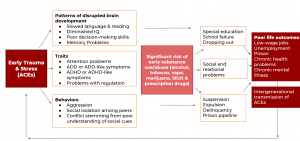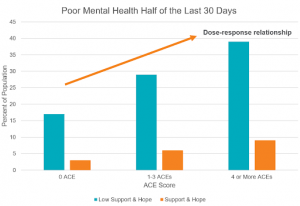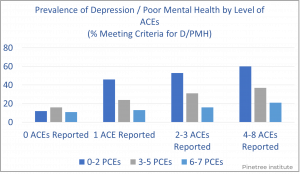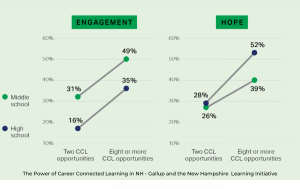The protective factors for mental health inherent to Career Technical Education (CTE) may offer opportunities to improve mental health and overall outcomes for learners, solidifying CTE’s role in not only preparing learners for the workforce but also for life. In part three of this four-part blog series, Senior Communications Associate and Mental Health Educator Jodi Langellotti uses the power of developmental relationships to establish CTE as a protective factor for mental health.
In the second blog in this series, we discussed how Dr. Christina Bethell and her colleagues at Johns Hopkins University conducted research that found that the more positive childhood experiences someone has, the greater the positive impact on their mental health as an adult regardless of how much adversity they may have faced in childhood. Additionally, positive childhood experiences were shown to help buffer the negative neurodevelopmental changes caused by adverse childhood experiences (ACEs) and other childhood trauma. Through this study, seven positive childhood experiences, or protective factors, were identified with three of them taking place within the home and the remaining four, within the community. For the purposes of connecting CTE to protective factors, we will focus on the four identified as taking place within the community as listed below.
- Had at least two non-parent adults who took genuine interest
- Felt supported by friends
- Felt a sense of belonging in school
- Enjoyed participating in community traditions
It is possible to further categorize these four community-based protective factors in a way that brings more concreteness to the idea of belonging and participating in community traditions as follows:
- Emotional Support: Feeling social/emotional support and hope
- Multiple Sources of Help: Two or more people who give concrete help when needed
- Reciprocity: Watching out for each other and doing favors for one another
- Social Bridging: Reaching outside the social circle to connect to help
The four community factors of support will serve as the foundation for grounding CTE’s role as a protective factor for mental health. Additionally, research coming out of the Search Institute provides additional evidence of CTE’s role in supporting mental health and positive learner outcomes.
Developmental Relationships Framework – Search Institute
The Search Institute has conducted a significant amount of research on how relationships can positively impact youth development, mental health, performance, and overall well-being. The Search Institute defines developmental relationships as “Close connections through which young people discover who they are, gain abilities to shape their own lives, and learn how to interact with and contribute to the world around them.”1
The Developmental Relationships Framework is broken down into five key elements, with 20 specific actions, that are proven to have positive impacts on youth sense of self, resiliency, mental health, and more. The five key elements are:
- Express Care: Show me that I matter to you.
- Challenge Growth: Push me to keep getting better.
- Provide Support: Help me complete tasks and achieve goals.
- Share Power: Treat me with respect and give me a say.
- Expand Possibilities: Connect me with people and places to broaden my world.
In 2023 the Search Institute released Developmental Relationships: The Roots of Positive Youth Development 10 Years of Youth Voice, Practitioner Wisdom, and Research Insights which provides insights into the positive impacts of developmental relationships.2
Here are just a few highlights of the identified positive outcomes of developmental relationships:
- Academic Outcomes: increased motivation to learn, level of interest in classroom content, grade point average (GPA), and critical thinking skills.
- Social-Emotional Competencies: increased social responsibility, teamwork, communication, and empathy and improved listening and conversation skills and emotional regulation.
- Other Thriving Indicators: improved goal setting, stretching to reach goals, self-efficacy, and identifying deep interests and increased sense of purpose.
CTE as a Protective Factor for Mental Health
The activities within CTE foster hope, support, and developmental relationships and therefore serve as a protective factor for youth mental health. To illustrate this concept clearly, the five key elements of the Developmental Relationships Framework will be connected to the four community factors of support as these are more concise while still being effective in connecting to the activities within CTE.

Developmental Relationships Framework image from Search Institute
In the image above, the five key elements of developmental relationships, represented in color within the pentagon, apply to one or more of the four community factors of support, listed in black text around the outside of the pentagon. Below are some examples of activities within CTE that fall under the four community factors of support.

Emotional Support
- The multi-year connections between teachers, peers, and industry professionals provide a variety of opportunities for a learner to feel supported both in and out of the classroom.
- The tangible nature of hands-on learning can make it easier for a learner to recognize their growth and progress and therefore increase their confidence and sense of self.
Multiple Sources of Help
- Through CTE learners increase their potential sources of help through participation in CTSOs, mentors, and connections to industry professionals.
- When learners feel they have a mentor that cares about them their sense of hope for graduating high school doubles.3
CTE especially shines in the categories of reciprocity (being able to receive and give) and social bridging (connecting with people and places to broaden their world).
Reciprocity
- Career Technical Student Organizations (CTSOs) provide opportunities for student leadership and student voice.
- Learners play an active role in their CTE journey, increasing their sense of self-efficacy.
- CTE provides significant opportunities for peer mentoring. Being a mentor can provide learners with a sense of purpose, self-confidence, and an increased sense of self-efficacy.
- Being able to contribute financially through paid work-based learning or summer youth employment opportunities and via skills learned in CTE programs can provide learners with an increased sense of purpose and self.
Social bridging
- Career exploration allows learners to see what is possible for their future and how work can connect to their passions and interests. Career exploration can also contribute to a learner’s sense of belonging as they connect their interests and skills to a class, program, or pathway.
- The social networking created through CTSOs, apprenticeships, and other work-based learning broadens a learner’s world, can increase their sense of belonging, and can help them to further develop their soft skills, increasing their chances for success outside of the classroom.
The above are provided as just an example of how the activities inherent to CTE support the aspects of developmental relationships and the four community factors of support. Connecting CTE to protective factors does not necessarily require us to do anything new. Rather, it requires increased intentionality and a better understanding of and messaging about how CTE can play an integral role in preparing learners for the workforce and life.
Questions for consideration
- What are the specific aspects of the CTE program within your state, institution, or district that serve as protective factors?
- What are some standout programs (or individuals) that could serve as model examples of the aspects you’ve identified above?
- What areas could use improvement or more intentional focus from the aspects you’ve identified above?
Looking Ahead
In the next blog in this series (part 4), we will discuss how to incorporate CTE’s role as a protective factor for mental health into program and recruitment messaging and communications and suggestions for next steps to continue the conversation with key collaborators and policymakers.
Additional Resources
- Search institute virtual workshops and professional learning: https://searchinstitute.org/professional-learning
- Developmental Relationships: The Roots of Positive Youth Development – 10 Years of Youth Voice, Practitioner Wisdom, and Research Insights—A Search Institute Position Paper https://d2pck61xhq74q6.cloudfront.net/The-Roots-of-Positive-Youth-Development-FNL.pdf
- Adverse Childhood Experiences: Prevention for Action, Centers for Disease Control https://www.cdc.gov/violenceprevention/pdf/ACEs-Prevention-Resource_508.pdf
- Healthy Outcomes from Positive Experiences: Positive Childhood Experiences and Adult Mental Health: https://positiveexperience.org/wp-content/uploads/2020/03/BRFShandout2-18.pdf
- The Power of Career Connected Learning in NH: https://nhlearninginitiative.org/wp-content/uploads/2023/09/Gallup-New-Hampshire-Learning-Initiative_-Report_2023.pdf
 Much of the information in this blog is from the author’s training as an Adverse Childhood Experiences Master Trainer through ACE Interface with Dr. Robert Anda and Laura Porter and through her volunteer work within the community mental health space.
Much of the information in this blog is from the author’s training as an Adverse Childhood Experiences Master Trainer through ACE Interface with Dr. Robert Anda and Laura Porter and through her volunteer work within the community mental health space.
Jodi Langellotti, senior policy associate


 On Tuesday, May 7, the House Education and Workforce Committee
On Tuesday, May 7, the House Education and Workforce Committee The guidance letter clarifies the legal requirements schools and institutions must adhere to in order to remain compliant with federal laws and emphasizes that non-compliance could lead ED to withhold federal funding. The guidance comes amid reported increases in antisemitic and other identity-based incidents on college campuses and within K-12 schools over the past several months.
The guidance letter clarifies the legal requirements schools and institutions must adhere to in order to remain compliant with federal laws and emphasizes that non-compliance could lead ED to withhold federal funding. The guidance comes amid reported increases in antisemitic and other identity-based incidents on college campuses and within K-12 schools over the past several months.








 Once you’ve done your research and understand the job landscape in your area, it’s time to share that information and vision with your fellow educators, administrators, and Departments of Education. Gather testimonials from your past learners. Talk to employers in your community about learners they’ve worked with. Find ways to get others on board and see the impact of CTE in your school, district, and state.
Once you’ve done your research and understand the job landscape in your area, it’s time to share that information and vision with your fellow educators, administrators, and Departments of Education. Gather testimonials from your past learners. Talk to employers in your community about learners they’ve worked with. Find ways to get others on board and see the impact of CTE in your school, district, and state.  As a State CTE leader, you’re responsible for ensuring that essential information is properly collected, stored, and communicated to relevant agencies. However, many educators find data management difficult and time-consuming.
As a State CTE leader, you’re responsible for ensuring that essential information is properly collected, stored, and communicated to relevant agencies. However, many educators find data management difficult and time-consuming.
 Some states focus on a broad strokes approach that expands access to the sector as a whole. Last year,
Some states focus on a broad strokes approach that expands access to the sector as a whole. Last year,  Other states developed more focused career-specific pathways in close collaboration with industry partners.
Other states developed more focused career-specific pathways in close collaboration with industry partners. 

